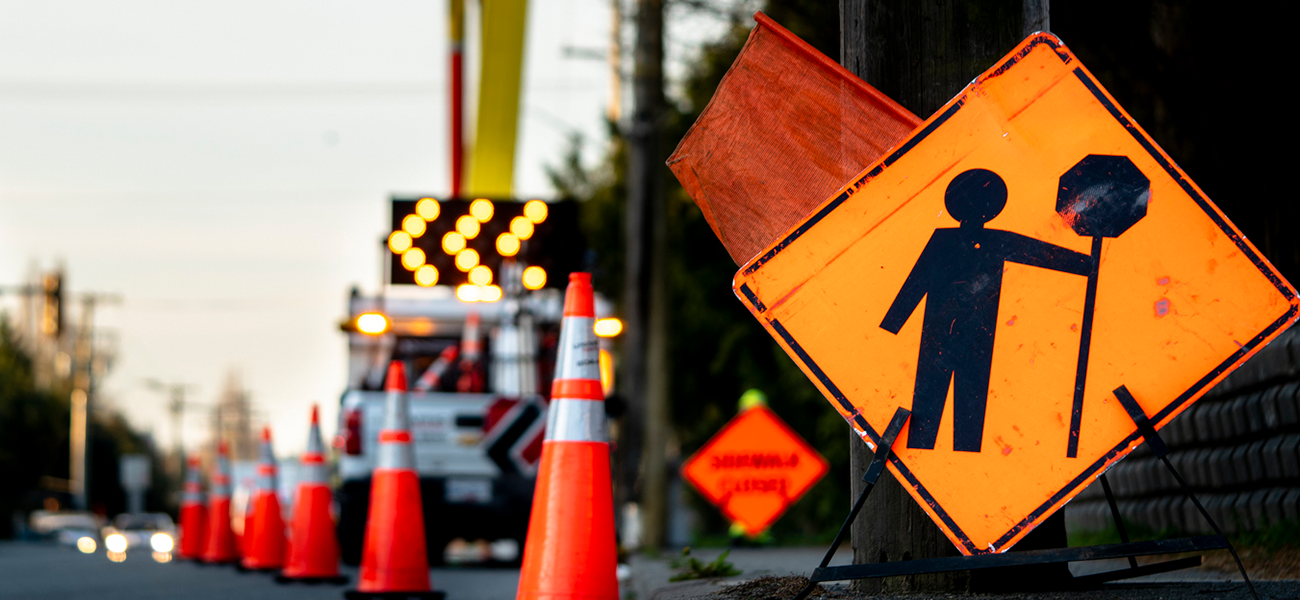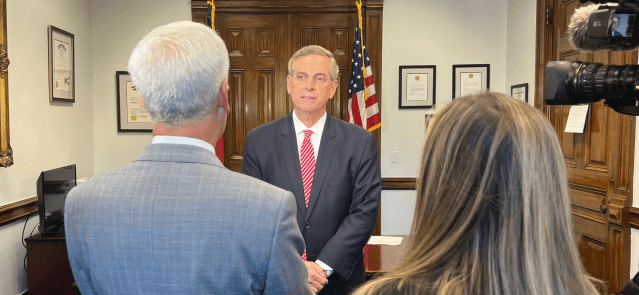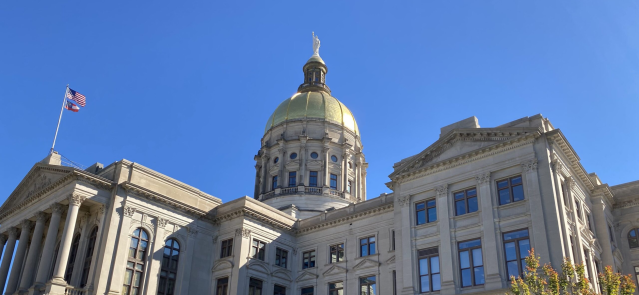Stay ahead of the curve as a political insider with deep policy analysis, daily briefings and policy-shaping tools.
Request a DemoKeeping Tabs on $70 Billion in Georgia Road Construction

Credit: iStock
- Georgia plans to spend $70 billion on road and bridge construction through 2050.
- Few high-price roadwork projects see lengthy delays or blown budgets.
- Higher gas tax has pumped $4.6 billion into roadwork and maintenance since 2015.
How quickly Georgia drivers see hundreds of roads and bridges fixed up to avoid traffic headaches depends on billions of new tax dollars amassed since 2015.
Less than half of Georgia’s nearly 126,000 miles of state and local highways had pavement in good condition as of 2019, totaling a distance larger than two trips around the world potentially in need of road upkeep in the coming decades, according to state Department of Transportation estimates. Meanwhile, populations in the Atlanta and Savannah metro areas are booming, combining with the state’s airports and shipping port to pile up traffic for drivers headed to work and commercial trucks that fuel the state’s busy freight industry.
To help tackle the problem, state and local officials are tapping more revenues from motor-fuel taxes to fund road construction, focusing especially in areas around cities where jobs and commercial truck routes tend to cluster. Local transportation advocates have high hopes that state officials are ready for the wave of construction projections, noting roadwork managers show a good track record of keeping projects mostly on time and on budget.

The number of roadwork projects have shot up in Georgia since the state passed an increase in the gas tax in 2015. (Credit: Brittney Phan for State Affairs)
Georgia officials aim to pump around $70 billion into road and bridge projects between 2021 and 2050, drawing from a mix of federal funds and a recent boost in state motor-fuel taxes to overhaul interstate connections, replace bridges and repave roads.
That money pool ranks road construction and maintenance as one of the most expensive tax-funded services in Georgia, behind only the state’s public K-12 schools and colleges and Medicaid programs. At roughly $3.6 billion, much of the state transportation agency’s budget this year comes thanks to a boost in Georgia’s motor-fuel tax that took effect in 2015, bumping the tax on gasoline from 7.5 cents per gallon plus sales tax to now about 28 cents per gallon.
The tax hike has helped state officials spend more than $6.5 billion on road and bridge construction since the gas tax’s increase, marking a dramatic increase compared to the roughly $273 million spent in 2015 before the gas tax hike, according to officials’ estimates.

Road construction slows traffic on Piedmont Road in Atlanta. (Credit: Beau Evans for State Affairs)
Most road and bridge projects have gone off without much of a hitch in recent years, giving advocates confidence in the state’s ability to handle the large amount of future roadwork.
Less than one-fourth of roughly 100 of the state’s priciest roadwork projects completed between fiscal years 2017 and 2020 missed their original deadlines to wrap up work, according to State Affairs’ analysis of state data. Of those, only a fraction of projects blew their deadlines by six months or more.
Likewise, only a handful of projects during that time spent more money to finish construction than were originally budgeted, state data shows. Just five projects of the roughly 100 reviewed overshot their budgets by $1 million or more, while many more projects came in under budget.
State officials can penalize slow-performing contractors by charging fees for missed deadlines and limiting problematic contractors’ ability to bid for new projects, according to Natalie Dale, a spokeswoman with the transportation agency. Overall, local advocates have faith that state officials can keep good tabs on roadwork contractors as hundreds more road, bridge and interstate projects roll out in the coming years.
“They’ve done a good job of administering that money,” Seth Millican, the executive director of the advocacy group Georgia Transportation Alliance, said of state officials’ handling of new revenues from the increased gas tax. “By any objective measure, that was an extraordinarily successful piece of legislation.”

This map shows Georgia’s highway system of federal interstates and state and local roads. (Credit: Georgia Department of Transportation)
Georgia cities and counties also have benefited from the gas-tax legislation to the tune of nearly $1.3 billion in grants for routine maintenance since 2015, according to state officials’ estimates.
The 2015 legislation also gave local governments the ability to levy new sales taxes specifically for road and bridge construction. To date, 33 of Georgia’s 159 counties have passed new sales taxes for construction since 2015. Another 63 counties have collected separate road-focused sales taxes as a region since 2010, according to data from the nonprofit Association of County Commissioners of Georgia.
The new local sales taxes have pumped hundreds of millions of dollars into city and county governments for roadwork, including roughly $140 million during the 2017 fiscal year, according to a Georgia State University report.
“It’s a good tool to have,” said Kathleen Bowen, one of the association’s legislative directors. “But there’s never going to be enough money for transportation. There’s just never going to be enough.”
 This map shows which Georgia counties have passed sales taxes for road construction (called “TSPLOST”) since 2015. (Credit: Association of County Commissioners of Georgia)
This map shows which Georgia counties have passed sales taxes for road construction (called “TSPLOST”) since 2015. (Credit: Association of County Commissioners of Georgia)
Cities and counties own the vast majority of Georgia’s roads and bridges with little state oversight of many local construction projects, making it tough to gain a complete picture of how well each government manages their local projects.
Some delays with city and county-run road construction have drawn frustration from local residents, such as slow-going work for a road in Roswell that sparked a recent investigation by city officials, reported the North Fulton Neighbor.
State transportation officials keep watch of roadwork projects that combine state and local funds, as well as the nearly $1.3 billion in state maintenance grants sent to cities and counties since 2015. Strictly local construction doesn’t have that level of oversight, advocates say.
“I’m guessing it’s all over the board,” Tom Gehl, the governmental relations director at the nonprofit Georgia Municipal Association, said about local roadwork timeliness. “It’s probably some cities and counties do a great job, and also maybe some contractors who don’t do a great job.”

Crews work on widening I-16 near Savannah in one of the state’s major road construction projects. (Credit: Georgia Department of Transportation)
On top of state and local funds, Georgia transportation officials have a pile of federal dollars available for major road projects that face additional budget and timing requirements alongside the state’s own monitoring.
Nearly half of the state transportation agency’s current $3.6 billion budget comes from federal funds, much of which will go to add lanes and overhaul connections for major interstates over the next decade including I-85, I-285 and I-16. While delays recently hit a $1.7 billion project for new express lanes on metro Atlanta’s GA-400, local advocates see the overall influx of state, federal and local roadwork as key to easing traffic and opening up freight channels amid Georgia’s growing population.
“Growth continues to be a challenge,” said the transportation alliance’s Millican. “I think we’re seeing an unprecedented level of cooperation among our agency folks in terms of talking about what’s important for our state in terms of infrastructure investments.”
What else would you like to know about Georgia’s roads and public transit? Share your thoughts/tips by emailing [email protected].
Gov. Kemp calls on state agencies to be fiscally restrained amid record $16.5B surplus
The Gist Gov. Brian Kemp asked the state’s 51 government agencies for continued fiscal restraint when drafting their amended fiscal year 2025 and 2026 budgets. Most agencies adhered to his request even as the state’s general fund surplus hit a record $16.5 billion last month. Forty-five agencies, excluding state courts, followed the governor’s instructions to …
Georgia defies bomb threats as election chief declares a “free, fair and fast” vote amid record turnout
ATLANTA – Despite dealing with over 60 bomb threats, Georgia’s election chief said Tuesday the state’s general election went smoothly. Georgia had a record turnout with nearly 5.3 million people voting, Secretary of State Brad Raffensperger told reporters. Election officials in the state’s 159 counties have until 5 p.m. to certify votes. “We had a …
In the (state)house: Meet the newest members of the Georgia legislature
When lawmakers reconvene at the state Capitol on Jan. 13, there’ll be a cadre of new faces in the 236-member Georgia General Assembly, one of the nation’s largest state legislatures. All 236 statehouse seats were up for election this year. Most candidates ran unopposed. Incumbents in contested races easily kept their seats, with the exception …
2 young Democrats win Statehouse seats as Republicans hold majority
ATLANTA — Many Statehouse incumbents appeared to beat back challengers Tuesday, ensuring their return to the Capitol in January. Republicans retain control of the House and Senate. Two Generation Z candidates will join the 236-member Legislature as new members of the House of Representatives: Democrats Bryce Berry and Gabriel Sanchez. Berry, a 22-year-old Atlanta middle …




